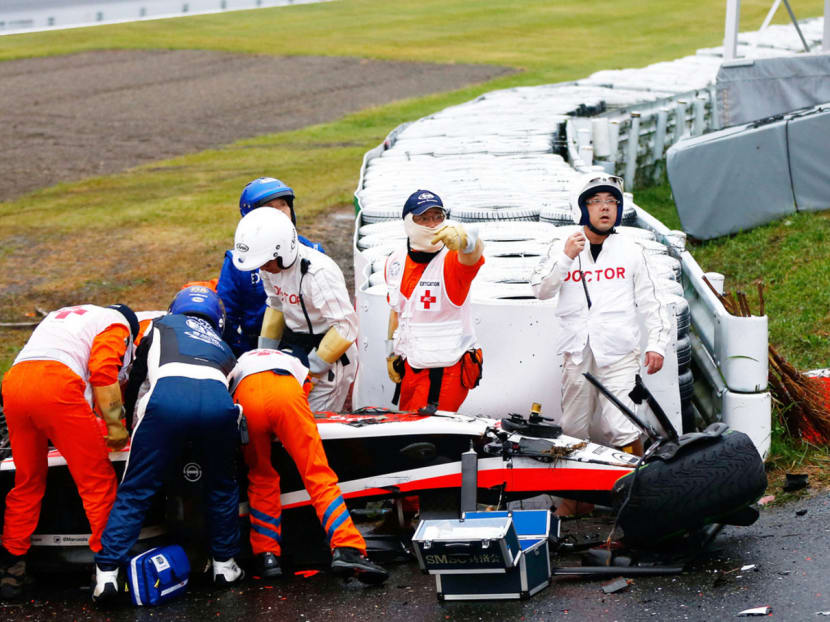Brake-system failure a factor in Bianchi’s crash
PARIS — An “incompatible” brake-by-wire system on Formula 1 driver Jules Bianchi’s Marussia car may have influenced the speed at which he crashed into a recovery vehicle at the Japanese Grand Prix on Oct 5 that left him still unconscious and in critical condition.

Bianchi receiving urgent medical treatment after crashing at the Japanese Grand Prix on Oct 5. The magnitude of the blow and the glancing nature of it caused massive head deceleration and angular acceleration, leading to his severe injuries. PHOTO: GETTY IMAGES
PARIS — An “incompatible” brake-by-wire system on Formula 1 driver Jules Bianchi’s Marussia car may have influenced the speed at which he crashed into a recovery vehicle at the Japanese Grand Prix on Oct 5 that left him still unconscious and in critical condition.
A 396-page report by a 10-man panel commissioned by motorsport’s world body, the FIA, to investigate the crash found that the Frenchman did not slow sufficiently under warning flags, and that medical services were not at fault in their handling of the aftermath.
However, leading motorsports news website Autosport reported that the panel’s findings also revealed the brake-by-wire (BBW) system on Bianchi’s Marussia car was “incompatible” with fail-safe systems on F1 cars that shut the engine when the brakes and throttle are applied simultaneously, and which could have influenced the speed — 126 kmh — at which Bianchi’s car hit the truck that was recovering Adrian Sutil’s Sauber.
Bianchi is now at a hospital in southern France after being flown home last month from Japan.
“During the two seconds Bianchi’s car was leaving the track and traversing the run-off area, he applied both throttle and brake together, using both feet,” said the report. “The FailSafe algorithm is designed to over-ride the throttle and cut the engine, but (this) was inhibited by the torque coordinator, which controls the rear brake-by-wire system.
“Bianchi’s Marussia has a unique design of BBW, which proved to be incompatible with the FailSafe settings. The fact that the FailSafe did not disqualify the engine torque requested by the driver may have affected the impact velocity; it has not been possible to reliably quantify this.
“However, it may be that Bianchi was distracted by what was happening and the fact that his front wheels had locked, and been unable to steer the car such that it missed the crane.
“Bianchi’s helmet struck the sloping underside of the crane. The magnitude of the blow and the glancing nature of it caused massive head deceleration and angular acceleration, leading to his severe injuries.”
The 10-man panel included former Mercedes team boss Ross Brawn, ex-Ferrari team principal Stefano Domenicali and two-time world champion Emerson Fittipaldi. The report recommended a speed limit be imposed in any section of track where double yellow warning flags are being displayed.
Other measures included improved circuit drainage and a recommendation that the calendar be reviewed to avoid holding races during local rainy seasons.
The Frenchman’s injury is the most serious in F1 since triple-world champion Ayrton Senna’s death at the 1994 San Marino Grand Prix.
“If drivers adhere to the requirements of double yellow flags ... then neither competitors nor officials should be put in immediate or physical danger,” the report added.
“Bianchi over-controlled the oversteering car, such that he left the track earlier than Sutil, and headed towards a point ‘up-stream’ along the barrier. Unfortunately, the mobile crane was in front of this part of the barrier, and he struck and under-ran the rear of it at high speed along the barrier.”
A Reuters report added that the FIA panel also found that neither a closed cockpit on the car, nor the fitting of a skirt around the crane, would have protected Bianchi from serious injury.
“It is considered fundamentally wrong to try and make an impact between a racing car and a large and heavy vehicle survivable,” it said. “It is imperative to prevent a car ever hitting the crane and/or the marshals working near it.”





